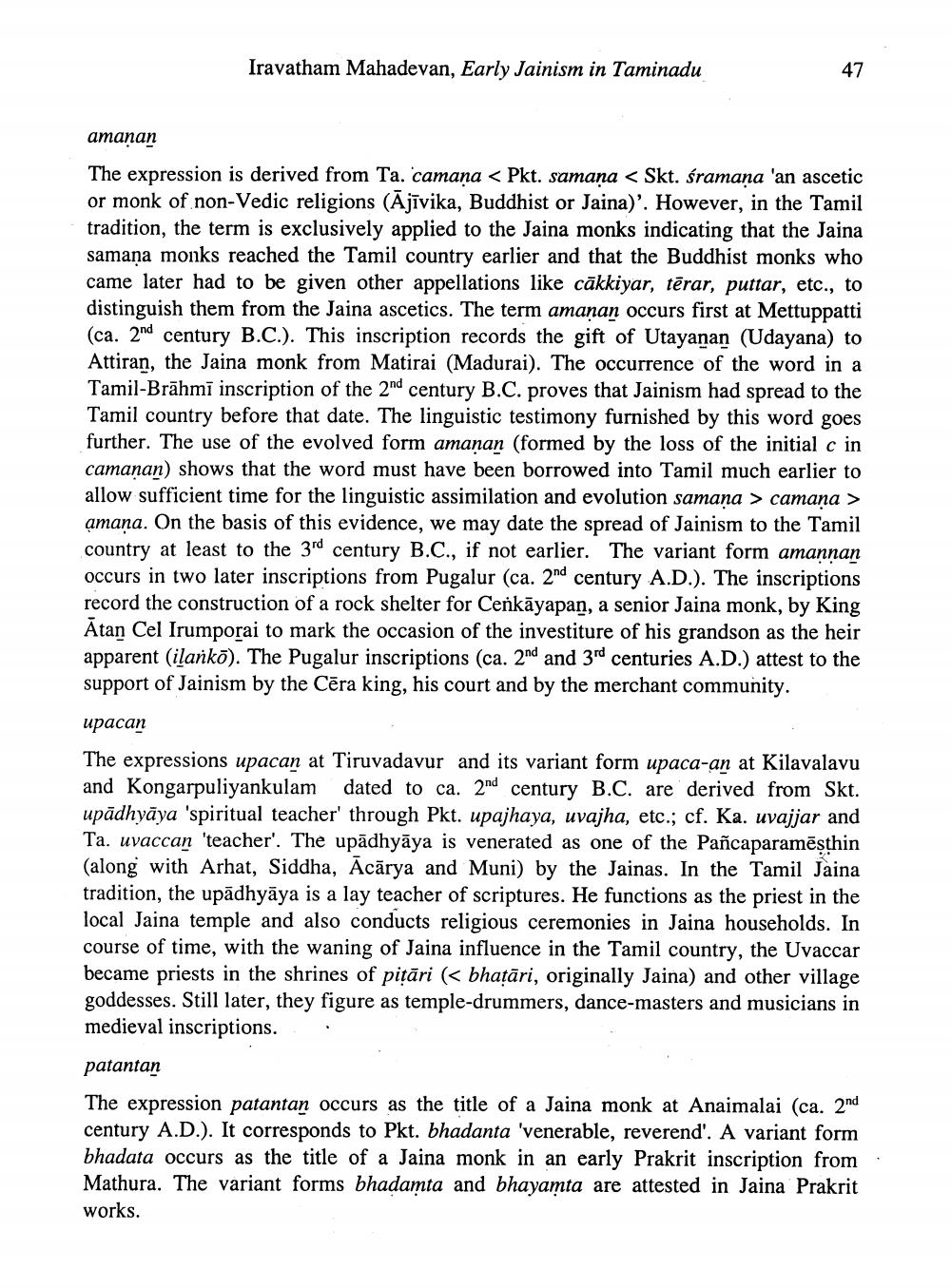________________
Iravatham Mahadevan, Early Jainism in Taminadu
amanan
The expression is derived from Ta. camana < Pkt. samana < Skt. śramana 'an ascetic or monk of non-Vedic religions (Ajīvika, Buddhist or Jaina)'. However, in the Tamil tradition, the term is exclusively applied to the Jaina monks indicating that the Jaina samana monks reached the Tamil country earlier and that the Buddhist monks who came later had to be given other appellations like cākkiyar, tērar, puttar, etc., to distinguish them from the Jaina ascetics. The term amanan occurs first at Mettuppatti (ca. 2nd century B.C.). This inscription records the gift of Utayanan (Udayana) to Attiran, the Jaina monk from Matirai (Madurai). The occurrence of the word in a Tamil-Brāhmī inscription of the 2nd century B.C. proves that Jainism had spread to the Tamil country before that date. The linguistic testimony furnished by this word goes further. The use of the evolved form amanan (formed by the loss of the initial c in camanan) shows that the word must have been borrowed into Tamil much earlier to allow sufficient time for the linguistic assimilation and evolution samana > camana > amana. On the basis of this evidence, we may date the spread of Jainism to the Tamil country at least to the 3rd century B.C., if not earlier. The variant form amannan occurs in two later inscriptions from Pugalur (ca. 2nd century A.D.). The inscriptions record the construction of a rock shelter for Cenkāyapan, a senior Jaina monk, by King Ātan Cel Irumporai to mark the occasion of the investiture of his grandson as the heir apparent (ilanko). The Pugalur inscriptions (ca. 2nd and 3rd centuries A.D.) attest to the support of Jainism by the Cēra king, his court and by the merchant community.
ирасап The expressions upacan at Tiruvadavur and its variant form upaca-an at Kilavalavu and Kongarpuliyankulam dated to ca. 2nd century B.C. are derived from Skt. upādhyāya 'spiritual teacher' through Pkt. upajhaya, uvajha, etc.; cf. Ka. uvajjar and Ta. uvaccan 'teacher'. The upādhyāya is venerated as one of the Pañcaparamēsthin (along with Arhat, Siddha, Acārya and Muni) by the Jainas. In the Tamil Jaina tradition, the upādhyāya is a lay teacher of scriptures. He functions as the priest in the local Jaina temple and also conducts religious ceremonies in Jaina households. In course of time, with the waning of Jaina influence in the Tamil country, the Uvaccar became priests in the shrines of pițāri (< bhatāri, originally Jaina) and other village goddesses. Still later, they figure as temple-drummers, dance-masters and musicians in medieval inscriptions. .
patantan The expression patantan occurs as the title of a Jaina monk at Anaimalai (ca. 2nd century A.D.). It corresponds to Pkt. bhadanta 'venerable, reverend'. A variant form bhadata occurs as the title of a Jaina monk in an early Prakrit inscription from Mathura. The variant forms bhadamta and bhayamta are attested in Jaina Prakrit works.




